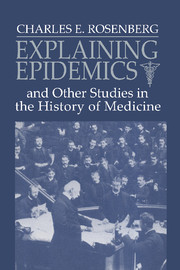Book contents
- Frontmatter
- Contents
- Acknowledgments
- Introduction: Why care about the history of medicine?
- I Ideas as actors
- II Institutions and medical care
- 7 The practice of medicine in New York a century ago
- 8 Social class and medical care in nineteenth-century America: The rise and fall of the dispensary
- 9 From almshouse to hospital: The shaping of Philadelphia General Hospital
- 10 Making it in urban medicine: A career in the age of scientific medicine
- III The past in the present: Using medical history
- Index
9 - From almshouse to hospital: The shaping of Philadelphia General Hospital
Published online by Cambridge University Press: 29 March 2010
- Frontmatter
- Contents
- Acknowledgments
- Introduction: Why care about the history of medicine?
- I Ideas as actors
- II Institutions and medical care
- 7 The practice of medicine in New York a century ago
- 8 Social class and medical care in nineteenth-century America: The rise and fall of the dispensary
- 9 From almshouse to hospital: The shaping of Philadelphia General Hospital
- 10 Making it in urban medicine: A career in the age of scientific medicine
- III The past in the present: Using medical history
- Index
Summary
The distinction between public and private philanthropy, means tested and universal aid, stigmatizing as opposed to nonstigmatizing government expenditure is as old as the history of social welfare itself in North America. And it characterizes the gratuitous provision of medical care just as it does any other aspect of public welfare. We see it at the end of the twentieth century in the distinction between medicare and medicaid; in an earlier period Americans experienced it in the distinction between almshouse (later municipal hospital) and voluntary hospital care. The problems that created the need for our earliest hospitals – poverty, trauma, and chronic disease – have not gone away and our modes of responding to them are still marked by traditional attitudes and assumptions, most significantly, the distinction between “worthy” and “unworthy” recipients of public benevolence. In American welfare policy at least, the more things change the more they seem to stay the same.
This continuity is demonstrated with unmistakable clarity in the following case study of Philadelphia's now-deceased public hospital. In formal terms, the Philadelphia General Hospital evolved from its beginnings as one aspect of the aid provided in an almshouse – an undifferentiated facility in which all those Philadelphians unable to provide for themselves received minimum care. In the course of the nineteenthcentury, the almshouse's medical wards gradually evolved into a hospital in name and bureaucratic identity.
- Type
- Chapter
- Information
- Explaining Epidemics , pp. 178 - 214Publisher: Cambridge University PressPrint publication year: 1992



